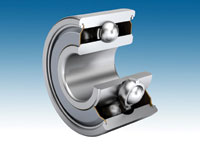
Posted to News on 27th Jul 2015, 00:00
Bearing design adds value in aviation applications
Bearings are critical components in a variety of auxiliary aircraft applications, including navigational gyroscopes, air cycle machines, actuators, gearboxes, primary and secondary flight controls, starter generators, hydraulic pumps and cabin fan bearings.

>However, the decision in favour of a specific bearing solution should always be taken after analysing the whole life costs of the bearing and not merely on the basis of purchase price alone. Today's advanced high technology bearings offer many improved features that enable whole life cost reductions to be achieved - despite an overall higher bearing price - providing added value over the complete life of aircraft systems and equipment.
>The influence of an improved design in reducing whole life costs and adding value over life can be significant, as designed-in savings are often sustainable and permanent. For example, a 5% price reduction from a bearing supplier held at that reduced price over 5 years is not likely to last beyond that point. However, a 5% reduction in assembly time/cost, or a 5% reduction in maintenance costs over the same 5-year period is much more desirable.
>For aircraft actuation systems in which the bearings are local to the point of actuation and high vibration levels are expected, super precision bearings can be designed with dissimilar ball and race materials in order to reduce adhesive wear.
>Customised internal bearing designs can be created that maximise load carrying capacity and stiffness. In applications where design envelopes are small, the bearing design can be optimised for ease of assembly and to reduce assembly times. For example, screw threads on assembly mating surfaces can be incorporated into the bearing design.
>Other features can be added to the bearings that add further value over the life of the aircraft system. These include special sealing technology within the bearing to help save space; super finished raceways to improve bearing lubrication film generation; anti-rotation features to prevent slippage under the effects of rapid changes in speed and direction of rotation; and optimising bearing operation under boundary lubrication conditions.
>For aircraft auxiliary equipment such as pneumatic and electric starters, generators and gearboxes, bearing configurations range from standard deep groove bearings to intricate split inner ring designs. Bearing designs can be customised to meet high speed, reliable operation and quiet running with minimum power losses.
>Due to their unique design, split inner ring configurations can accept reversing thrust and combination loads. The bearings are assembled with one-piece high strength cages that are often silver-plated for improved operation under marginal lubrication conditions. Bearing designs can also include puller grooves and flanges. Ceramic balls can be included to enable higher speed operation.
>Other typical configurations for aircraft auxiliary equipment include deep groove bearings that are greased for life at the factory in clean assembly room conditions. 'T' cages are often recommended for these bearings as they are lightweight and strong, but also enable high speed operation.









